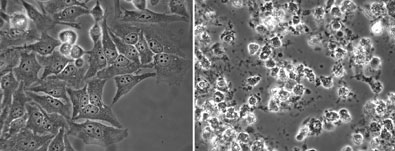| Posted: April 21, 2008 |
Peptides provide fatal blow for cancer cells |
|
(Nanowerk News) Peptide nanostructures that punch holes in cancer cells are 'the first step towards efficient nanochemotherapeutics,' say chemists in Canada.
|
|
Normand Voyer and colleagues at the University of Laval in Québec have designed a series of modified peptide nanostructures that can puncture cancer cell membranes, leading to the cells' death ("Nanoscale tools to selectively destroy cancer cells" – free access article).
|
|
The team explains that in the past decade, cancer cell resistance to chemotherapeutic agents has led to increased cancer deaths. 'We believe that nanochemotherapeutics can overcome this problem due to the particular properties of nanometre-sized compounds,' says Voyer.
|
|
Basing their structures on a membrane-disrupting peptide they had made previously, the researchers engineered analogues that would be selective for cancer cells. The engineered peptides are inactive until they reach cancer cell surfaces where they convert into an active cell membrane disruption agent. Since the enzyme that activates the peptides is over-expressed in prostate cancer cells, normal cells do not activate the peptide to the same extent, leading to the peptides' selectivity.
|
 |
| When cancer cells (left) are treated with peptide nanostructures their cell membranes are destroyed (right)
|
|
Vincent Rotello, an expert in the supramolecular chemistry of biological and materials systems at the University of Massachusetts, Amherst, US, is enthusiastic about the findings. 'While enzymatic activation has been used before for therapeutics,' he says, 'this peptide-based scaffold has great promise due to the modular nature of its construction.' This is because the amino acid building blocks used to assemble the peptides can be readily varied, which provides 'incredible control over the structure and dynamics of the eventual therapeutics,' Rotello adds.
|
|
Voyer explains that the work 'illustrates chemists' abilities to design novel nanometre-sized molecular architectures from scratch to address highly challenging problems.' Future efforts will be geared towards 'determining the mechanism of action of this new class of antitumour agents,' he adds.
|

